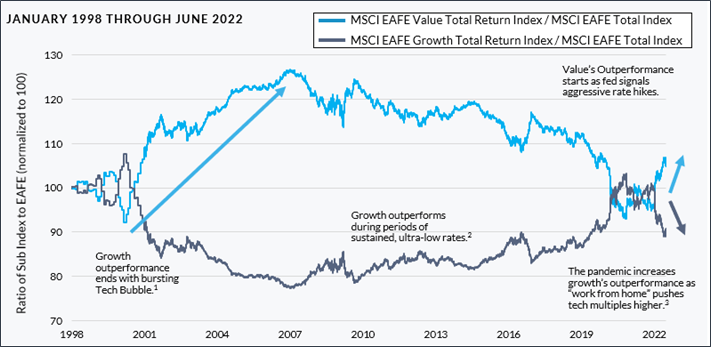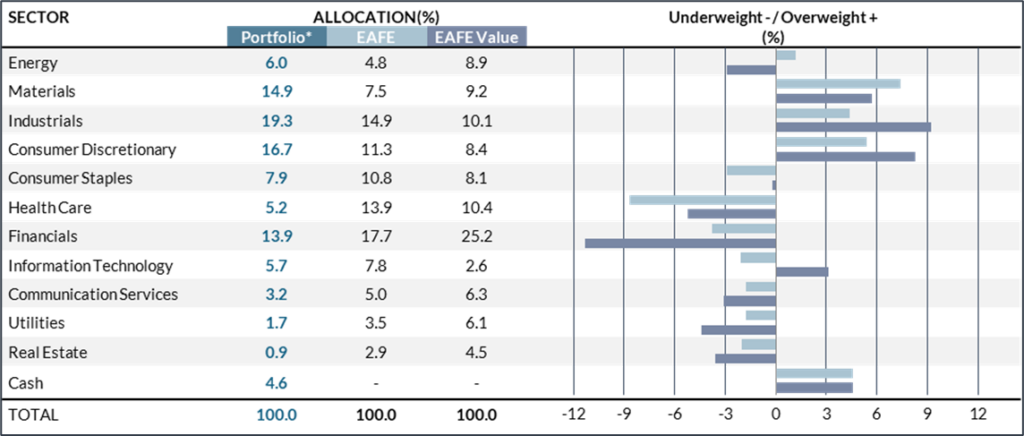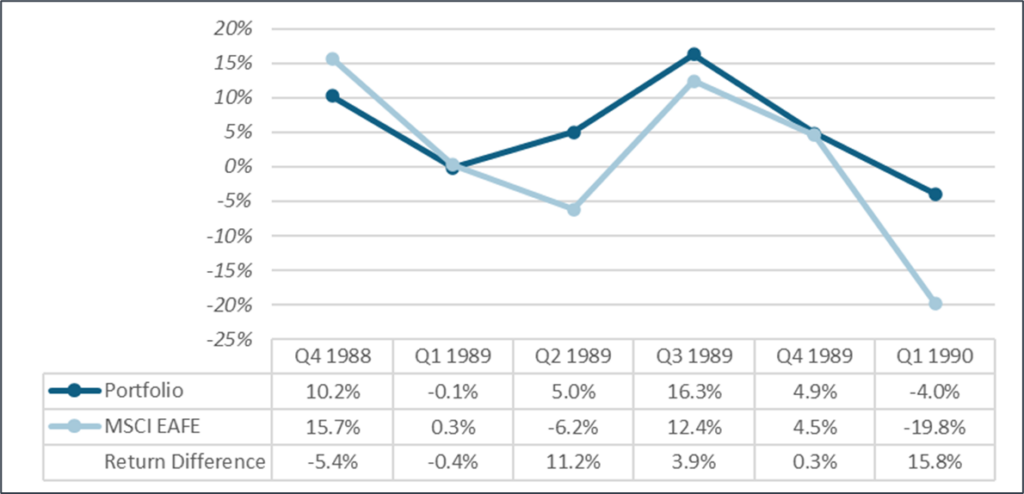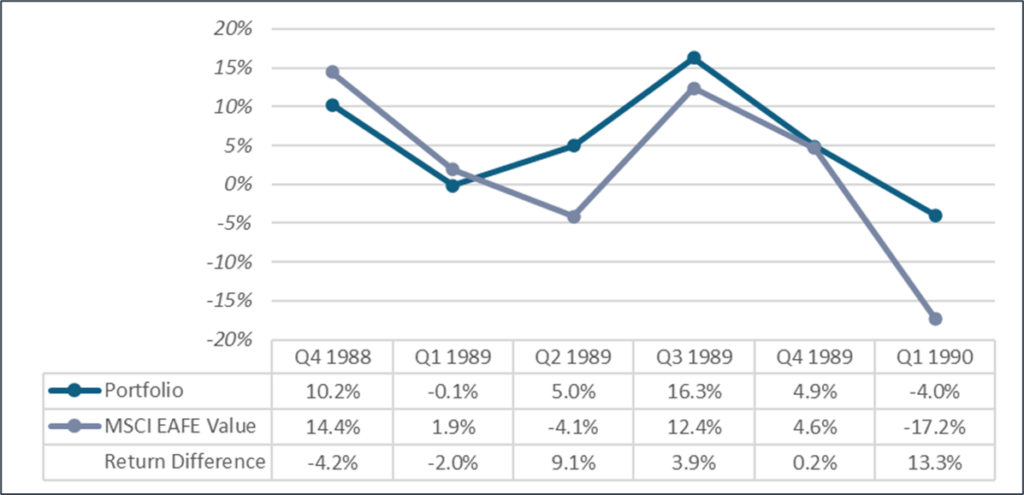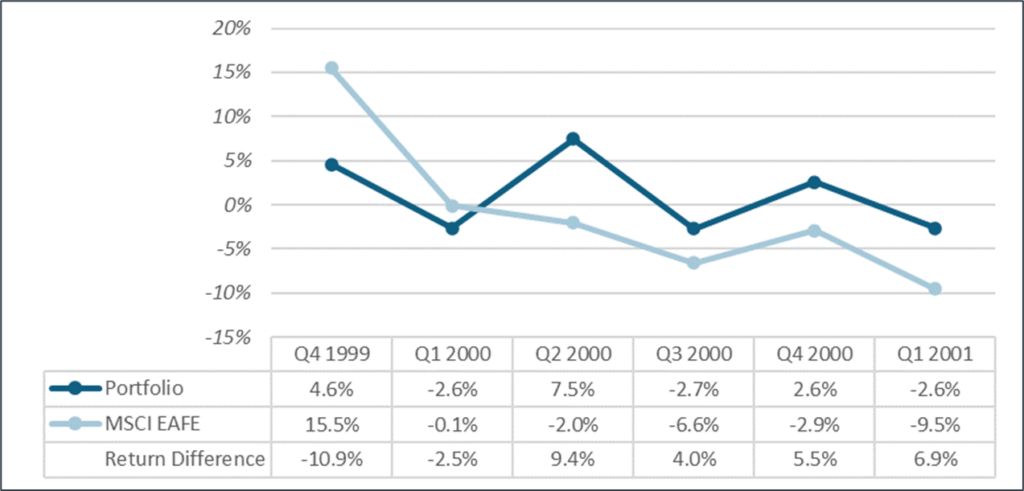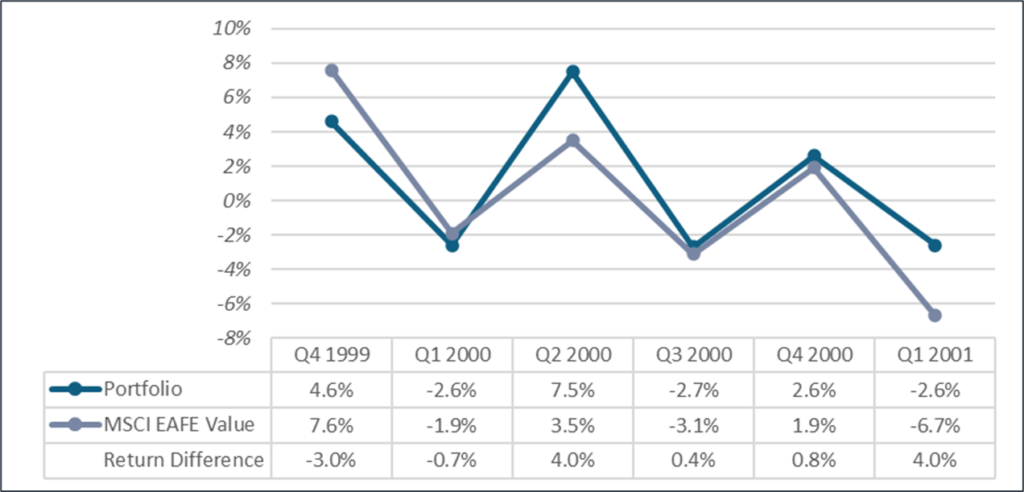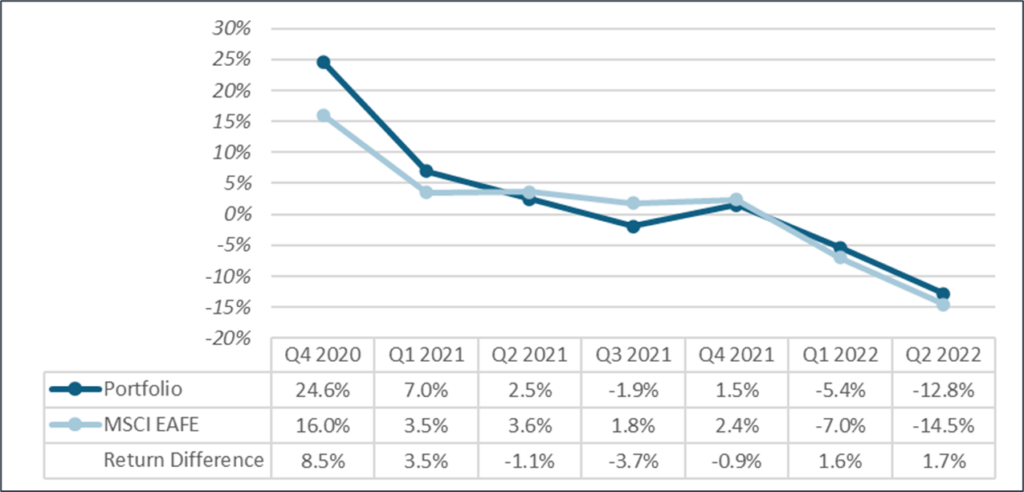THIS SITE IS INTENDED ONLY FOR INSTITUTIONAL INVESTORS AND INVESTMENT PROFESSIONALS – NOT FOR RETAIL DISTRIBUTION
The information provided herein is designed for institutional investors, consultants, and investment professionals and is published for informational purposes only. In particular, this site is intended only for such qualifying individuals to provide information about the investment strategies and opportunities offered by Sprucegrove Investment Management Ltd. (“Sprucegrove”). Material and information provided herein are not intended for retail investors and/or distribution to the general public in any jurisdiction.
Past performance is not indicative of future results. The information contained on this site is not intended as an offer or solicitation for the purchase or sale of any financial instrument. The views and opinions expressed are provided for general information purposes only, and do not constitute specific tax, legal, or investment advice to, or recommendations for, any person.
Sprucegrove offers a variety of products and services intended solely for investors from certain countries or regions. Sprucegrove does not offer these products or services outside their intended countries or regions. Your country of legal residence will determine the products or services that will be available to you. None of the information provided herein should be considered a solicitation or offer for the purchase or sale of any investment product or service to any person in any jurisdiction where such solicitation or offer would be unlawful. No representation is given that the securities, products, funds, or services discussed on, or accessible through, this site are suitable for any particular investor.
In Canada, Sprucegrove, is registered as a Portfolio Manager in the provinces of Alberta, British Columbia, Manitoba, New Brunswick, Newfoundland and Labrador, Nova Scotia, Ontario, Quebec and Saskatchewan. Sprucegrove is also registered as an Investment Fund Manager in the provinces of Ontario, Quebec, and Newfoundland and Labrador.
In the United States, Sprucegrove is an investment adviser registered with the Securities and Exchange Commission.
By accessing this site, you represent and certify that you meet one or more of the permitted investor categories for use of this site and acknowledge that you understand and agree to be bound by the terms of use contained within the notices and policies disclosed herein.
Legal Notice
-
Company and Regulation Details
In Canada, Sprucegrove is registered as a Portfolio Manager in the provinces of Alberta, British Columbia, Manitoba, New Brunswick, Newfoundland and Labrador, Nova Scotia, Ontario, Quebec and Saskatchewan. Sprucegrove is also registered as an Investment Fund Manager in the provinces of Ontario, Quebec, and Newfoundland and Labrador.
In the United States, Sprucegrove is an investment adviser registered with the Securities and Exchange Commission
sprucegrove.ca is provided by Sprucegrove. is provided by Sprucegrove.
-
Residence and Jurisdiction
This site is intended for the information of residents in countries in which Sprucegrove is legally permitted to offer its investment advisory services. The information on our site does not constitute an offer or solicitation to purchase or sell units or shares in any Sprucegrove fund in any jurisdiction in which such offer, solicitation or distribution would be unlawful or in which the person or entity making such offer or solicitation is not qualified to do so or to anyone to whom it is unlawful to make such offer or solicitation.
-
General Disclaimers and Terms
While Sprucegrove has taken all reasonable care to ensure that the information contained within the pages of this site is accurate, current and in compliance with relevant legislation and regulations in Canada and the United States as of the date of issue, errors or omissions may occur due to circumstances outside our control. We reserve the right to change the content, presentation, performance, facilities and availability of all or part of the pages of this site in our sole and absolute discretion and without prior notice. We make no warranty or representation that the pages of this site can be accessed at all times during the Canadian hours of business stated on this site. This site may be temporarily unavailable or restricted for administrative or other reasons. We will not be liable for any loss or damage arising out of, or in connection with, the loss of the use of this site.
If you are in any doubt as to the accuracy of any information contained within the pages of this site, or if you require any further information, you may wish to email us.
We do not accept any responsibility for information contained in any external third-party sites which can be accessed by hypertext link from these pages or for these other sites not being available at all times. The links to any external third-party sites are provided for general information purposes only and such sites and their respective contents are not endorsed or promoted by us in any way, unless otherwise stated. Please note that when you click on any external site hypertext link you will leave this site and access the external third-party site at your own risk.
Commissions, management fees, and other expenses and costs all may be associated with fund investments. Please read the offering documents before investing. Please remember that investments are not guaranteed, their values change frequently, and past performance is not a guide to future performance. The value of units and shares and the income from them (if any) can go down and up and investors may not get back their originally invested amounts. Exchange rate changes may cause the value of foreign investments to rise or fall. For further details on any of the funds or products please read the relevant offering documents.
By accessing these pages you shall be deemed to have accepted and agreed to be bound by the terms of this Legal and Regulatory Information page which shall be governed by the laws of Canada.
-
No Warranties; Limitations of Liability
THE ACCURACY, COMPLETENESS, SEQUENCE OR TIMELINESS OF THE MARKET DATA AND OTHER INFORMATION ACCESSIBLE ON OR THROUGH THIS SITE CANNOT BE GUARANTEED. SPRUCEGROVE DOES NOT WARRANT THIS SITE (INCLUDING THE MARKET DATA OR OTHER INFORMATION ACCESSIBLE ON OR THROUGH THIS SITE) FOR ANY PARTICULAR PURPOSE. IT IS PROVIDED “AS IS” AND ON AN “AS AVAILABLE” BASIS. SPRUCEGROVE DISCLAIMS, TO THE FULLEST EXTENT OF THE LAW, ANY WARRANTY OF ANY KIND, WHETHER EXPRESS OR IMPLIED, AS TO ANY MATTER RELATING TO THIS SITE (INCLUDING MARKET DATA OR OTHER INFORMATION ACCESSIBLE ON OR THROUGH THIS SITE), INCLUDING WITHOUT LIMITATION THE IMPLIED WARRANTIES OF MERCHANTABILITY, FITNESS FOR A PARTICULAR PURPOSE, AND NONINFRINGEMENT. USE OF THIS SITE IS AT YOUR OWN RISK.
SPRUCEGROVE AND ITS DIRECTORS, OFFICERS, EMPLOYEES AND LICENSORS WILL NOT BE LIABLE OR HAVE ANY RESPONSIBILITY OF ANY KIND FOR ANY LOSS OR DAMAGE (INCLUDING DIRECT, INDIRECT, CONSEQUENTIAL, SPECIAL OR OTHER DAMAGES) THAT YOU INCUR ARISING FROM OR IN CONNECTION WITH: (1) ANY DELAY, TERMINATION, FAILURE, DEFECT, OR INTERRUPTION IN THE TRANSMISSION OF THIS SITE OR ANY MARKET DATA OR OTHER INFORMATION ACCESSIBLE ON OR THROUGH THIS SITE; (2) ANY INACCURACY, ERROR, UNAVAILABILITY, OR INCOMPLETENESS IN THE TRANSMISSION OF THIS SITE OR ANY MARKET DATA OR OTHER INFORMATION ACCESSIBLE ON OR THROUGH THIS SITE; (3) ANY TERMINATION OR INTERRUPTION OF YOUR ACCESS TO THIS SITE; (4) YOUR RELIANCE ON OR USE OF THIS SITE OR ANY MARKET DATA OR OTHER INFORMATION ACCESSIBLE ON OR THROUGH THIS SITE; (5) ANY EMAIL REQUESTS, ORDERS, OR INSTRUCTIONS YOU SEND, OR THE INTERCEPTION BY THIRD PARTIES OF ANY REQUESTS, ORDERS, OR INSTRUCTIONS YOU SEND VIA EMAIL; (6) ANY ACT OR OMISSION OF SPRUCEGROVE IN MAKING THIS SITE OR MARKET DATA OR OTHER INFORMATION ACCESSIBLE ON OR THROUGH THIS SITE AVAILABLE TO YOU; OR (7) ANY OTHER CAUSE RELATING TO YOUR ACCESS TO OR USE OF THIS SITE, WHETHER OR NOT THE CIRCUMSTANCES GIVING RISE TO SUCH CAUSE MAY HAVE BEEN WITHIN THE CONTROL OF SPRUCEGROVE OR WITHIN THE CONTROL OF ANY OTHER PARTY PROVIDING SOFTWARE OR SERVICES SUPPORT FOR THIS SITE.
SPRUCEGROVE DOES NOT WARRANT THAT THIS SITE, OR THE FUNCTIONS CONTAINED IN THIS SITE, WILL BE UNINTERRUPTED OR ERROR-FREE, THAT DEFECTS WILL BE CORRECTED, OR THAT THIS SITE, OR THE SERVERS THAT MAKE IT AVAILABLE, ARE FREE FROM VIRUSES OR OTHER HARMFUL COMPONENTS. YOU ASSUME THE ENTIRE COST OF ANY NECESSARY SERVICING, REPAIRING, OR CORRECTING OF YOUR PROPERTY OR OPERATIONS AS A RESULT OF USING THIS SITE. YOU ACCEPT AT YOUR OWN RISK THAT THE INTERNET OR OTHER ONLINE COMMUNICATIONS MEDIUM MAY NOT PERFORM AS INTENDED AS A RESULT OF HUMAN, MECHANICAL, OR OTHER ERROR, DESPITE THE EFFORTS OF SPRUCEGROVE, YOU, OR ANY THIRD PARTY.
IN NO EVENT WILL SPRUCEGROVE OR ITS DIRECTORS, OFFICERS, OR EMPLOYEES BE LIABLE TO YOU FOR ANY DIRECT, INDIRECT, SPECIAL, CONSEQUENTIAL, OR INCIDENTAL DAMAGES RELATED IN ANY WAY TO YOUR USE OF THIS SITE, EVEN IF: (A) SUCH DAMAGES ARE REASONABLY FORESEEABLE; OR (B) SPRUCEGROVE OR ANY OTHER PARTY HAS BEEN ADVISED OF THE POSSIBILITY OF SUCH DAMAGES.
-
Advice
Nothing on this site shall be deemed to constitute financial, investment, tax, legal or other professional advice in any way and you should consult your financial adviser or other professional adviser if you require any financial or other professional advice.
-
Copyright and Trademarks
All trademarks, service marks, trade names, logos, icons and other content on this site remain the property of Sprucegrove. Nothing contained on the site should be construed as granting, by implication, estoppel, or otherwise, any license or right to use any trademark displayed on this site without the prior written permission of Sprucegrove or such third party that may own the trademarks displayed on this site. You may not use the trademarks displayed on this site, or any other content on this site, except as provided herein.
-
Email and Other Electronic Communications
Please note that there is no guarantee that any electronic communication sent will be received by us, or that the contents of any such electronic communication will remain private or unaltered during transmission. If you have any such concerns you may prefer to telephone or send mail to us instead. We accept no liability for any damages you or others may suffer as a result of the alteration or loss of confidentiality of such information.
We filter, monitor and retain electronic communications to protect our systems and keep them running smoothly, and to comply with applicable regulations and industry standard business practices.
-
Downloads
Any material or information downloaded from this site is provided on an “as is” basis without warranty or condition and is installed and used at your own risk. We do not warrant the suitability of any such material or information which is downloaded and accept no liability for any problems with your computer that may arise as a result. If you are in any doubt as to the suitability of material or information to be downloaded for your computer it is recommended that you obtain specialist advice before downloading.
-
Privacy
You consent to the collection, use and disclosure of your personal information by Sprucegrove in accordance with the terms of and for the purposes set forth in its privacy policies.
-
Cookie Policy
Your use of this site is subject to the terms of our Cookie Policy.
-
Miscellaneous
This agreement represents the complete and exclusive statement of the agreement and understanding between you and Sprucegrove regarding your rights to access and use this site and supersedes all prior and contemporaneous agreements and representations regarding such subject matter. Except as herein provided, no waiver, modification or amendment of any provision to this agreement shall be effective against Sprucegrove unless the same is in writing and signed by an authorized official of Sprucegrove. Sprucegrove’s failure to insist at any time upon strict compliance with any term of this agreement, or any delay or failure on Sprucegrove’s part to exercise any power or right given to Sprucegrove in this agreement, or a continued course of such conduct on Sprucegrove’s part shall at no time operate as a waiver of such power or right, nor shall any single or partial exercise preclude any other future exercise. All rights and remedies given to Sprucegrove in this agreement are cumulative and not exclusive of any other rights or remedies which Sprucegrove otherwise has at law or equity.
-
Our Social Media Terms and Conditions
Our “Social Media Platforms” include LinkedIn and other platforms we make available and use from time to time.
Social media sites are in the public domain. We are not responsible for, and do not endorse, the content posted by users of these other sites.
General Social Media Considerations
- For your own security, we ask that you do not include personal or account information, including login details, in any content you post, comment or message you send on our Social Media Platforms.
- We are not responsible for the terms of use or privacy or security policies of any of our Social Media Platforms or any external third-party site that may be linked to them and you use these at your own risk.
- Please ensure that contributions to our Social Media Platforms are relevant and topical. We reserve the right to block any user or follower of our Social Media Platforms who posts or reposts content that we deem inappropriate or offensive or which constitutes a testimonial, advice, recommendation, or advertisement for securities, products, or services or is promotional in nature. We also reserve the right to block users or followers whose own social media platforms contain offensive or inappropriate content or serve as promotional sites.
- Any opinions expressed by users on our Social Media Platforms are those of the persons submitting the opinion and do not necessarily represent our views.
No Offer
Nothing contained on any of our Social Media Platforms constitutes an offer, solicitation or recommendation regarding any investment management product or service, or the offer to sell or the solicitation of an offer to buy any security. All content is subject to applicable statutes and regulations.
Not all investment management products, funds, or services are available in all jurisdictions. Any potential investor should satisfy themselves that a product, fund, or service is permissible under the rules and regulations of their jurisdiction.
All investments are subject to risk, including the possible loss of money you invest.
No Advice
The information posted to our Social Media Platforms by us represents our current opinions and are subject to change without notice. These posts have been provided for information purposes only and should not be considered as investment advice or a recommendation of any particular service, security, fund, investment strategy, or investment product. Please consult a qualified professional for this type of advice. Please refer to offering documents for further information concerning specific funds or products.
Information provided or referred to by us on our Social Media Platforms may contain statements of future expectations and other forward-looking statements that are based on our current views and assumptions and involve known and unknown risks and uncertainties that could cause actual results, performance or events to differ materially from those expressed or implied in such statements. In addition to statements which are forward-looking by reason of context, the words “may, will, should, expects, plans, intends, anticipates, believes, estimates, predicts, potential, or continue” and similar expressions identify forward-looking statements. All views and assumptions contained in forward-looking statements are subject to change without notice. There is no specific intention of updating any forward-looking statements whether as a result of new information, future events or otherwise.
Geographic Exclusion
We communicate to external audiences through our Social Media Platforms in a manner consistent with applicable regulatory requirements. Content on our Social Media Platforms is not directed to any person in any jurisdiction where, by reason of that person’s nationality, residence or otherwise, the publication or availability of the content is prohibited. Persons in respect of whom such prohibitions apply should not access the content.
PRIVACY
This Privacy Policy explains how we collect, use and disclose your personal information and outlines your options to withdraw or refuse your consent.
In this policy, the word “Information” means personal, financial and other details about you that you provide to us and we obtain from others outside our organization, including through the products and services you use.
Authorization
You acknowledge, authorize and agree to allow Sprucegrove to obtain, verify, give, share and exchange Information about you, now and in the future, with any individuals, financial institutions, business corporations or other parties with whom you have or may have financial personal dealings, or who hold information about such dealings, such as credit bureaus. You also authorize any person that Sprucegrove contacts under this authorization to provide such Information.
You acknowledge that we may amend this policy from time to time to take into consideration changes in legislation or other issues that may arise.
Collecting, Using and Disclosing your Information
The Information that you provide to Sprucegrove (or Sprucegrove collects with your consent) with respect to your investor onboarding documentation will be protected and maintained in a client investment file with us.
We may collect, use and disclose your Information to:
- Confirm your identity and the accuracy of the Information provided by you, or collected with your consent;
- Conduct searches to locate you and update your contact information in your file;
- Properly administer and service any financial services and products that Sprucegrove provides to you;
- Keep records of instructions given by you over the telephone;
- Provide you with details of other financial service offered by Sprucegrove; and
- Comply with applicable legal and regulatory requirements.
Before Sprucegrove collects, uses and discloses your Information for any other purpose, we will explain the purpose to you and seek your consent.
Who May Access Your Information
Access to your Information will be limited to:
- Sprucegrove’s employees, representatives and their respective delegates, in the performance of their duties for Sprucegrove;
- Sprucegrove’s employees when resolving your concerns about any related product offerings;
- Affiliated companies or other issuers of investments named in any forms completed for your benefit;
- Service providers used by Sprucegrove, in the performance of their duties for Sprucegrove;
- Those to whom you gave permission; and
- Those authorized by law.
Additional Collections, Uses and Disclosures
We may also use your Information for marketing purposes, including to
- Better understand your financial needs and activities so that we may tell you about other products and services that may be of interest to you;
- Conduct research and surveys to assess your satisfaction with us as a client, and to develop products and services to meet your needs; and
- Contact you by telephone, email, mail, and other methods.
With respect to these marketing purposes, you may choose not to have us:
- Contact you occasionally either by telephone, email, mail, or all of these methods, with offers that may be of interest to you; and
- Contact you to participate in client research and surveys.
Service Providers
Sprucegrove may use external and related service providers for printing services, mail services, distribution services, information technology services, administrative services, and marketing services. Some of our service providers may be located outside of Canada.
As a result, your Information may be accessible to regulatory authorities in accordance with the law of these jurisdictions. We may change service providers or enter into agreements with new service providers. Where Information is provided to our service providers to perform the various services they provide, we will contractually require them to protect the Information in a manner that is consistent with Sprucegrove’s privacy policies and practices.
Withdrawing Your Consent
Subject to any legal and contractual restrictions described above, you may withdraw your consent to Sprucegrove’s collection, use and disclosure of your Information at any time.
Depending on the circumstances; however, withdrawal of your consent may impact our ability to continue to provide you with certain services or information that may be of value to you.
You understand that the withdrawal of certain kinds of consent may delay or preclude our ability to provide contracted services. We will act on your instructions as quickly as possible, but there may be certain uses of your Information that we may not be able to stop immediately.
You cannot refuse our collection, use and disclosure of Information required by third-party service providers essential for the provision of the services or required by regulators.
Reporting Privacy Breaches
A privacy breach is the loss of, unauthorized access to, or disclosure of, Personal Information resulting from a breach of an organization’s security safeguards. Upon the occurrence of a privacy breach or a potential privacy breach, Sprucegrove will investigate and evaluate the implications of the breach of security safeguards. Sprucegrove will report the breach to the appropriate regulatory body and/or applicable organization as soon as feasible after we have determined the breach occurred and such reporting will occur within the prescribed timelines for certain jurisdictions. We will also notify affected individuals if the breach creates a real risk of significant harm to an individual as soon as feasible after the organization determines that the breach has occurred, unless giving notice is otherwise prohibited by law. Sprucegrove will take immediate steps to prevent future breaches after taking all necessary steps to mitigate the risks associated with a breach of security safeguards.
Your Right to Access Your Information or Receive Additional Information
You may request additional information or request access to your Information in your file at any time, subject to the restrictions provided by law, and ask that any inaccurate or incomplete Information be corrected. To do so, you may send a written request with details to the Chief Privacy Officer at the following address:
Sprucegrove Investment Management Ltd.
181 University Ave, Suite 1300
Toronto, Ontario
M5H 3M7
Attention: Chief Privacy Officer
Additional Information for California Residents
Please view our additional information for California residents. This additional information is provided for purposes related to the California Consumer Privacy Act of 2018, as amended (the “CCPA”) and applies to Information which is subject to CCPA.
Additional information for California residents
PRIVACY NOTICE FOR CALIFORNIA RESIDENTS
This Privacy Notice (“Notice”) supplements the information contained in the Sprucegrove Investment Management Ltd. (“Sprucegrove”) main Privacy Policy [link to main policy] and applies only to residents of California. This Notice is provided in compliance with the California Consumer Privacy Act 2018, as amended (the “CCPA”) and does not apply to personal information maintained by financial services firms that is covered under certain exceptions described in the CCPA, including, but not limited to, the provisions of the Gramm-Leach-Bliley Act.
We may need to make changes to this Notice to reflect new legislation, industry practice or company policy changes. We encourage you to review this Notice periodically to be informed of any changes.
Personal Information We Collect and Use
We collect types of information that identify, relate to, describe, reference, are capable of being associated with, or could reasonably be linked, directly or indirectly, with a particular consumer or device (“personal information”). This includes collecting the following categories of personal information in the last twelve (12) months:
- Identifiers, such as name, address, telephone number, email address, date of birth, IP address, internet user identifiers, social security numbers and account numbers;
Characteristics of classifications, such as your age, gender, marital status, nationality, or citizenship;
- Internet or other similar network activity, such as information on your interaction with our site including cookie identifiers; and
- Professional or employment-related information, such as current or past job history.
Where We Collect Your Personal Information
We collect personal information directly from individuals, their representatives or the organisations they represent. This personal information may be provided through:
- An application form for a product, service, or employment opportunity;
- Phone conversations with us;
- Emails or letters you send to us;
- Meetings with one of our business development or relationship managers; and
Registering for one of our events.
Why We Collect Your Personal Information
We take your privacy seriously and we will only ever collect and use information which is personal to you where it is fair and lawful to do so. We will collect and use your information for the following purposes:
- lTo provide the product or service you have requested (e.g., records of client meetings and reports);
- To meet our legal or regulatory obligations (e.g., anti-money laundering, tax reporting, and the detection and prevention of fraud);
- To issue communications and conduct analyses for marketing purposes, promotional materials, and events;
- To screen information for an employment opportunity; and
- To maintain and improve our site.
Who We Share Your Information With and Why
We do not sell personal information and have not sold personal information in the last twelve (12) months. The personal information we collect may be shared with third parties for the purposes listed herein. In the last twelve (12) months this has included:
- Service providers of Sprucegrove who support us in the provision of products and services;
- Companies we have chosen to support us in the delivery of the products and services we offer to you and other customers (e.g., research, consultancy, or technology companies); and
- Applicable law enforcement and regulators, such as the Securities and Exchange Commission.
Your Rights
The CCPA provides residents of California with a number of rights in relation to personal information. These are:
-
- The right to be informed about the personal information we collect and disclose; details of this are explained in this privacy notice;
- The right to access the personal information we collect and use, including specific
- pieces of personal information we have collected in relation to you;
The right to opt-out of the sale of your personal information; we do not sell personal information;
- The right to deletion of your personal information; and
- The right to non-discrimination for exercising any of these rights.
These rights only apply to personal information governed by the CCPA.
How to Exercise Your Rights
To make a request under the rights listed herein, you may contact us by either:
The exercise of your rights may be subject to your identity being verified (e.g., by matching the information provided by you with the information included in our records).
Upon receipt of a verifiable request, we will comply within the period stipulated in the CCPA. In the case of your right to access and delete the personal information we collect and use, this will be forty-five (45) days from the date of your request. In complex cases, this time may be extended to ninety (90) days from the date of your request. We will inform you if your request cannot be satisfied (e.g., where other legal obligations apply).
COOCKIE POLICY
Cookies are small text files, which often include a unique identifier that is sent by a web server to your computer, mobile phone or any other internet enabled device (“device”) when you visit a site. Cookies are widely used in order to make sites work efficiently and help provide us with business and marketing information to enable us to make informed decisions on the development of our site. We may collect information about your computer, including your IP address, operating system and browser type, for system administration and in order to create reports. This is statistical data about our users’ browsing actions and patterns and does not identify any individual. We use three main types of cookies: (1) “Performance” cookies, (2) “Identification” cookies, and (3) “Targeting” cookies.
- “Performance” cookies are used to help us see how you use our site (e.g., which pages you visit). These cookies do not collect any information that could identify you; all the information collected is anonymous and is only used to help us improve the performance of our site, understand what interests our users, and measure the effectiveness of our advertising. Sometimes cookies are managed for us by third parties, but we do not allow such third parties to use the cookies for any purpose other than those listed herein. By using our site, you accept the use of performance cookies.
- “Identification” cookies are used to help us customise site content based upon your selections. We use identification cookies to remember choices you have made such as identifying yourself as an adviser, to show you when you are logged in to our site and to target you with advertisements on other sites. You can control whether or not these cookies are used, but preventing them may mean you are unable to access certain features or services. Preventing these cookies may stop us remembering that you did not want a specific feature or service. By using our site, you accept the use of identification cookies.
- “Targeting” cookies are used to send you relevant information and see which content you use. We use targeting cookies to send you customised news content via email, to track which content you use and to target you with advertisements on other sites. By using our site, you accept the use of targeting cookies.
At any point, you have the right to request that we do not process your personal information for any marketing purposes.
You can opt-out of display advertising features and customise display network advertisements using the ad settings provided by Google and other ad serving companies. As an added privacy measure, you can also use the Google Analytics opt-out browser add-on or other third-party adblockers. However, please note that if you do this you may not be able to use the full functionality of this site.
To remove other cookies from your PC, you can use these guides:
We utilise a number of different cookie variations that serve a number of different functions.
Changes to the Policy
Please be aware that this Cookie Policy may be updated at any time. As such, please ensure that you regularly read the latest version of this page.
Questions
If you have any questions or complaints relating to this Cookie Policy or how we use the personal information we have about you, please email us and we will try to respond to you promptly.
Security
Stay Safe Online
As an investment business, we expect to find fraudulent schemes on social media and email from people pretending to represent Sprucegrove. We have robust processes and measures in place to manage activities like this and do everything we can to protect our clients.
If you get a social or email message and you are unsure if it is from us, you can send it to our mailbox and we will look into it for you. If you have any concerns you can
email us or call 416-363-5854.
LEGAL AND REGULATORY INFORMATION
Investment involves risk. The value of investments, and the income from them, can go down as well as up and an investor may get back less than the amount invested. Past performance is not a guide to future results.
The information contained in this site is of a general nature on the activities carried out by Sprucegrove. This information is therefore only indicative and does not constitute any form of contractual agreement, nor is it to be considered as an offer, investment recommendation, or solicitation to deal in any financial instrument or engage in any investment service or activity. No warranty whatsoever is given and no liability whatsoever is accepted for any loss arising whether directly or indirectly as a result of the reader, any person or group of persons acting on any information, opinion or estimate contained in this site.
Please note that some of the investments referenced in this site are not authorised for distribution in all of those jurisdictions in which we operate. For further information, please speak to a Sprucegrove representative.
Accessibility
Sprucegrove is committed to treating all people in a way that allows them to maintain their dignity and independence. We believe in integration and equal opportunity. We are committed to meeting the needs of people with disabilities in a timely manner, and will do so by preventing and removing barriers to accessibility and meeting accessibility requirements under the Accessibility for Ontarians with Disabilities Act (“AODA”) and the Integrated Accessibility Standards Regulations (“IASR”).
Sprucegrove will, upon request, provide or arrange to provide accessible formats and communication supports for Sprucegrove information. We are committed to providing or arranging to provide Sprucegrove information in a timely manner, taking into account the person’s accessibility needs.
Modern Slavery Statement
We believe that all forms of modern slavery; from human trafficking and forced labour, to bonded labour and child slavery; have no place in our society. As an investment company we want to do all that we can to help tackle these issues. We are committed to operating ethically, raising awareness of modern slavery issues, and encouraging good practices among our suppliers and the companies we invest in.
We work with a limited number of suppliers who provide us with various goods and services. The majority of our spending is with suppliers of fully managed outsourced services, operating systems, information technology and professional services which support our investment management process.
We ensure the management and oversight of all material service providers through our vendor due diligence process. These due diligence requirements involve cross-business representatives focusing on procurement, legal, sustainability, risk and compliance to ensure we continuously review and improve our approach.
The Canadian and United States financial services industry is not considered a high-risk sector for modern slavery. However, we are not complacent and recognise the possibility that modern slavery issues may exist somewhere in our supply chain. We expect transparency from our suppliers and will work with our business partners to support them in driving positive change. In the event that we did become aware of any modern slavery issues within any of our supply chains, this would be escalated to our Board of Directors through our risk management framework and appropriate action would be taken. Depending on the circumstances, this may range from supporting a supplier to make a positive change to terminating the relationship with a supplier. We also recognise that the biggest impact we can make is through our investment approach, engaging directly with high-risk companies and encouraging better practices as part of our commitment to environmental, social and governance (“ESG”).
A key way we can drive change is through how we invest. We incorporate ESG considerations into our investment approach across all mandates. We take our responsibilities as an investor seriously and seek to encourage the adoption of best-practice ESG standards. We expect that the companies in which we invest meet internationally recognised modern slavery standards and industry best practices. We also expect companies to report to shareholders regarding policies, practices and the performance of all the steps taken to address modern slavery issues. Where we believe a company is exposed to modern slavery risk and not taking action to mitigate this, we will incorporate this into our investment view and engage with the company to drive positive change.




